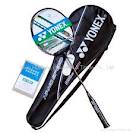Badminton was invented at least two thousand years ago, a form of sport played in ancient Greece, China and India. The game was
called 'POONA', In India during 18th century, and British army officers stationed there took the Indian version back to England.
That new sport was definitively launched in 1873 at Badminton house, Gloucestershire, owned by the Duke of Beaufort. During that time,
the game was referred to as 'The Game of Badminton', and the game's official name became Badminton.
The first All England Open Badminton Championship for men was started in the 1899, its became the first badminton competition in the world.
BADMINTON ORGANIZATION
The International Badminton Federation (IBF), now known as Badminton World Federation (BWF), was established in 1934 with Canada,
Denmark, England, France, Netherlands, Ireland, New Zealand, Scotland, Wales as its founding members. It became the sport's sole
international governing body in 1981.
COMPETITIONS
The International Badminton Federation (IBF) decided in March 1939 that the time had arrived for the inauguration of International competition,
its president, Sir George A Thomas Baronet offered a trophy for the winning team, the first Thomas Cup matches until the 1948 - 1949 season.
The idea of women's international team badminton championship was broached in 1950, it was turned down because of financial problems.
Mrs. H Uber of England donated the trophy, which called the Uber Cup, the first tournament was held during the 1956 - 1957 season.
The competitions take place once every two years, more than 50 national teams compete in qualifying tournaments within continental
confederations for a place in the finals. The final tournament involves 12 teams, following an increase from eight teams in 2004.
Since then, the number of world events has increased to seven; Thomas Cup (men's team), Uber Cup (woman's team), World Championships,
Sudirman Cup (mixed team), World Juniors, World Grand Prix Finals and The world Cup.
The Sudirman Cup, a gender-mixed international team event held once every two years began in 1989. To win the tournament, a country must
perform well across all five disciplines (man's doubles and singles, woman's doubles and singles, and mixed doubles).
Badminton was first contested as an official Olympic sport at the 1992 Olympic games in Barcelona, Spain.
Badminton is a game that somewhat resembles tennis and volley ball and involves the use of a net, lightweight rackets, and a shuttlecock,
a cork ball fitted with stabilizing feathers. It is played by two or four players on the badminton court, either indoors or outdoors on a marked out area 44ft (13.41m) long by 17ft (5.18m) wide for the two player game and 20ft (6.10m) wide for the four player game.
The players hit the shuttlecock back and forth over the net with the racket. Only the serving side can win a point. If the score is tied near
the end of a game, the game may be decided through a tie breaking procedure called setting, which involves different rules for men and women competition and depending on the point at which the score is tied.
RECORDS
The most powerful stroke in badminton is the smash, which is hit steeply downwards into the opponent's midcourt. The official badminton
smash record is 332 km/h (206 mph), set by Chinese badminton doubles player Fu Haifeng in the 2005 Sudirman Cup.
Tan Boon Heong of Malaysia recorded a faster smash, 421 km/h (262 mph), during Yonex's speed test of the Arcsaber Z-slash in 2009, but that
smash is not comparable to Fu's because it was hit while shuttles were being gently fed to Tan whereas Fu's smash was hit during an actual
match, and because Tan's was recorded by Yonex whereas Fu's was recorded by BWF officials.









